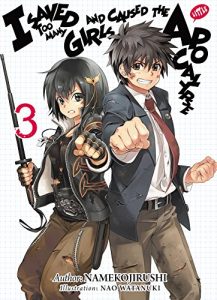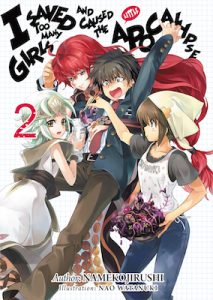By Namekojirushi and Nao Watanuki. Released in Japan as “Ore ga Heroine o Tasukesugite Sekai ga Little Mokushiroku!?” by Hobby Japan. Released in North America digitally by J-Novel Club. Translated by Adam Lensenmayer.
Life as a parody can be difficult, especially when it’s unclear whether you are a parody or not anymore. Little Apocalypse started off being pretty blatantly a parody of all of those harems with piles and piles of women, as well as titles where the male lead goes around “rescuing” the girl of the week (hi, Index). But as the volumes have gone on I think it’s safe to admit that sometimes it tends to forget this and just tries to be a straight up harem action novel. You can usually tell by the fact that the author is forgetting to include R’s sarcastic asides for dozens of pages at a time, and it’s R that reminds us that Rekka’s frustrating indecision and waffley-ness is not actually bad writing but a deliberate decision. That said, I would not blame those who hate indecisive male leads from dropping the series, though I do wonder why they started it in the first place.
We’re back to three girls on the cover, and the author brags in the afterword about having made it to double digits on the heroines. That said, one of the previous ones doesn’t even get mentioned, and a second is only mentioned in passing. As with Negima, all heroines are important but some heroines are more important than others. New heroines this time include Rosalind, the blonde loli vampire that you knew we were going to get sooner or later, and who serves as the main antagonist (though she’s also a heroine); Silver Slayer, a homunculus trained to destroy Rosalind who has been chasing her the last two hundred years or so; and Chelsea, a mage who is desperately searching for a way to save her dying little brother. Add to all this Hibiki (from Book 3), who actually brings Chelsea to Rekka; Lea (from Book 2), who’s there to provide some muscle; and the main three heroines from Book 1, who likely always will be the top heroines.
And then there’s Rekka, who continues to be the savvy-only-when-necessary male lead. As with most of these books, the first half drags quite a bit as we set up the pieces, and the second half is much better as the pieces all interlock and Rekka can deal with them all at the same time. When Rekka is fretting about having set up dates on Sunday with all the girls at the same time, the book sadly falls into the exact cliches it’s meant to be making fun of, and is not as interesting. (Also Christ, I hope he went to buy Harissa some clothes after this.) For a book that’s so low in page count, there’s a lot going on in each one – I didn’t mention the evil genie, or the Philosopher’s Stone. The author knows how to bring a situation to chaos and let it play out. He now needs to work harder on what to do when everything is at rest. Recommended for those who can tolerate a wishy-washy male lead, written by design. If you can’t, avoid this series with great avoid.



